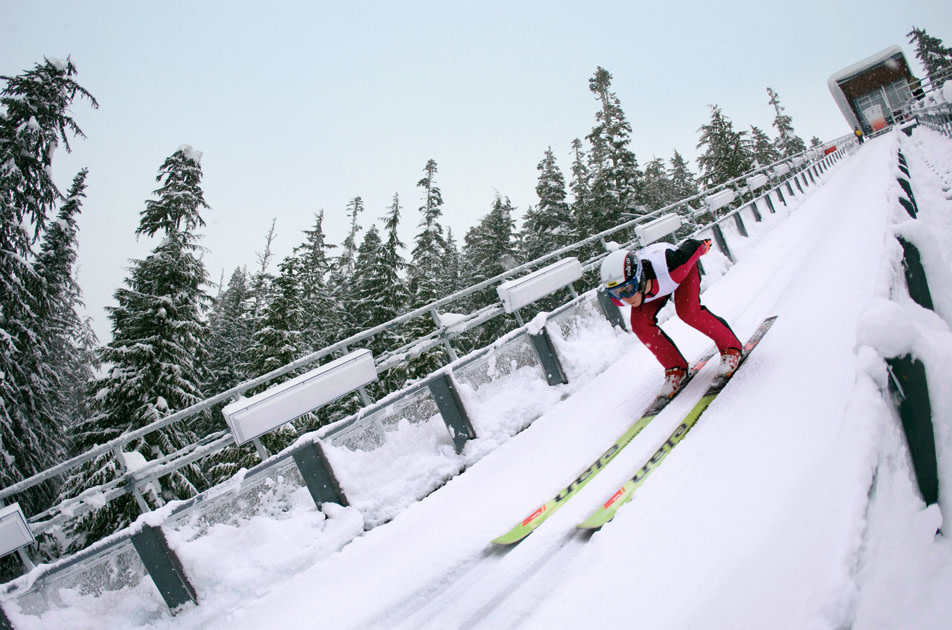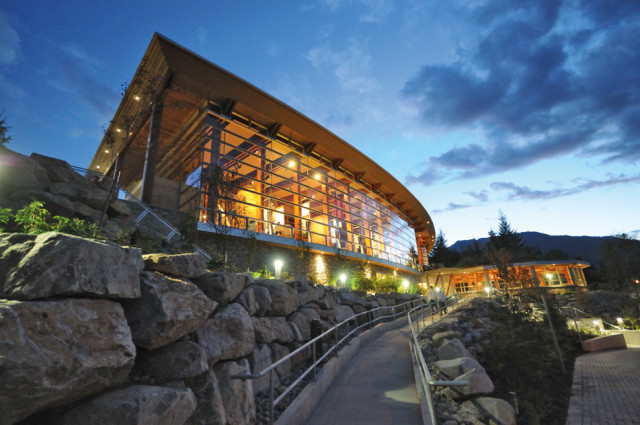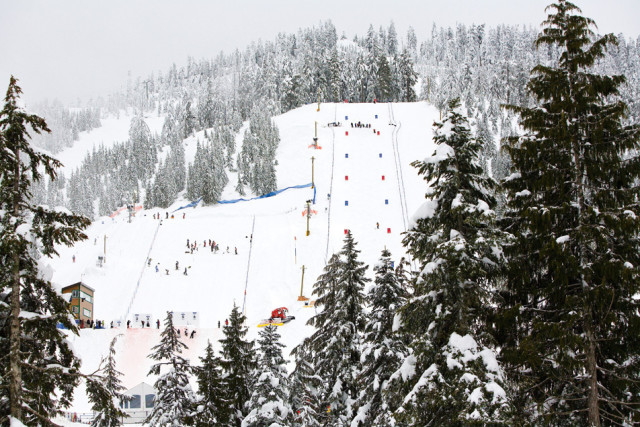Gold Rush

The ski jump at the new Whistler Olympic Park, developed for the 2010 Winter Games
AS THE PERIMETER Whistler Express shuttle pulled out of Vancouver, BC, and headed north toward Whistler on the Sea to Sky Highway, I gave up trying to control my excitement and succumbed to rubbernecking. To the west, views of coastal rain forests, glacier-cut bays, and hulking mountains whizzed by like some kind of National Geographic slide show—and this was just the warm-up.
My fellow passengers—a mix of Canadian, German, and Swedish powder hounds—and I were en route to Whistler Blackcomb, North America’s largest ski resort, which is home to not one but two mammoth mountains (Whistler to the south and Blackcomb to the north) and 8,171 acres of carvable terrain. All this is anchored by the town of Whistler itself, a thriving village full of nightclubs, upscale boutiques, and world-class restaurants stashed away at the base of the snowbound Coast Mountains in westernmost Canada.
Slope-side fantasies aside, I also wanted to see a ski town in transition: Come February 2010, Whistler, along with Vancouver, will co-host the 21st Olympic Winter Games. In preparation for the cities’ appearance on the world stage, some $1.4 billion (Canadian) has been spent in the area, including $600 million to improve the safety of the precipitously narrow and cliff-skirting Sea to Sky Highway—almost the only way to get into town. Whistler Blackcomb even has paid some $52 million to erect the Peak 2 Peak Gondola, slated to open this month. With nary a supporting span, the engineering marvel will whisk skiers and snowboarders between the two mountains (a distance of three miles) in less than 12 minutes.
Plus, I’d actually be able to tackle the same course that 2008 US slalom champion Jimmy Cochran will carve, a rollicking black-diamond run, christened the Dave Murray Downhill, that plummets 3,300 feet over 1.5 miles. On Blackcomb Mountain, I could visit the newly minted Whistler Sliding Centre, where members of the Canadian bobsled team were already clocking speeds in excess of 90 miles per hour—about 10 mph faster than the speeds reached at Torino’s 2006 Winter Games.
{page break}

Opened last June, the 30,400-square-foot Squamish Lil’wat Cultural Centre was designed o to resemble a traditional longhouse
Image: Gary Fiegehen,Gary Fiegehen
“I came here to ski for one winter,” the shuttle driver told me with a grin as we pulled into town. “That was 30 years ago.” Wandering down Whistler’s brick-lined walkways, I could understand why he stayed. The air was crisp, and the late-April sun filtered into cafés filled with people enjoying an après-ski beer. Presiding over all these scenes were those white-capped leviathans, omnipresent reminders of why the town exists at all.
In Village Square—a modest plaza near the center of the town’s main pedestrian walkway—I found a plaque memorializing the day Whistler won its Olympic bid. On July 2, 2003, some 5,000 locals, led by the mayor (who’d shaved his hair in the shape of a maple leaf for the event) converged here to watch a live telecast during which International Olympic Committee President Jacques Rogge announced that Whistler and Vancouver had beaten out Pyeongchang, South Korea, and Salzburg, Austria, for the 2010 Games. The crowd reportedly let loose an earsplitting roar, popped open bottles of champagne, and partied in the streets.
It was the culmination of a long-held dream for the resort and its mountains. In the early 1960s, when Franz Wilhelmsen, the man considered to be the founding father of Whistler’s ski scene, first set about turning Whistler Mountain (then called London Mountain) into a ski area, his intention was to host the Games. Enchanted by a trip to California’s 1960 Winter Olympics in Squaw Valley, the jet-setting Vancouverite became convinced that Whistler could do a better job. However, dogged by a lack of infrastructure and overshadowed by cosmopolitan Canadian cities like Calgary, Whistler never made the cut. Between 1960 and 1979, the Canadian Olympic Committee and the International Olympic Committee rejected five Olympic bids from the town. Wilhelmsen, who died in 1998, never saw his dream come to fruition.
And nor would I see mine. As I was renting snowboard equipment, I learned that the day before my arrival Whistler Mountain had closed for the season owing to low snow levels. So much for my Dave Murray Downhill run. Construction of the Peak 2 Peak Gondola meant tours of the Whistler Sliding Centre were cancelled, too.
Yet any disappointment I felt melted away once I was standing atop Horstman Glacier on Blackcomb Mountain, where the snowpack remained plenty thick. Below me, Fitzsimmons Valley plunged steeply before rising again on a wave of evergreens that gave way to the high alpine bowls and glaciers of neighboring Whistler Mountain. Pointing my board down the glacier, I found deep, untracked powder that plumed overhead as I carved long, booming S-turns under a big blue sky.
Long before any skiers arrived, the terrain I’d just covered was home to the Coast Salish First Nations people, a piece of regional history that the Vancouver and Whistler Olympic Organizing Committees want the anticipated legions of visitors to know. That explains Whistler’s new Squamish Lil’wat Cultural Centre, a 30,400-square-foot building of massive fir beams and soaring walls of glass that was designed to look like a traditional Squamish longhouse. Though the center was still a work in progress when I showed up (it opened to the public in June), Ron Nahanee, a carpenter and Squamish tribal member, was kind enough to show me around. “They were hoping it would be natives who built this, and for the most part it was,” he said as he led me through the galleries, soon to be filled with native artifacts, and into the 80-seat theater, which smelled of fresh cedar.
{page break}

Whistler Olympic Park
Image: V.A.N.O.C.,V.A.N.O.C.
The next day, still hoping to catch a bit of the Olympic spirit, I rented a car and drove to the new Whistler Olympic Park. Located 10 miles west of town in the rugged Callaghan Valley, the park, ringed by mountain peaks and old-growth forest, will be the site of the cross-country skiing, ski jumping, and biathlon events. Already open to the public, it features more than 30 miles of expertly groomed cross-country ski trails, a 164-foot biathlon shooting range, and two roller-coaster-size ski jumps.
My intent was simply to walk the grounds that one day will host hundreds of elite athletes, but when I drove up, I couldn’t believe what I saw: three lanky guys clad in blue-and-red Lycra suits emblazoned with “USA.”
In an adrenaline-fueled act of uncharacteristic impulsiveness, I burst out of the car and ran toward them. “Hey!” I shouted. “Are you Olympic athletes?”
Chewing nonchalantly on a Clif bar, one of them said they were junior members of the biathlon team. After I assured them I wasn’t a nut job, they introduced me to their coach, Mikael Löfgren, a four-time Swedish Olympian who won two bronze medals in the biathlon during the 1992 Games in Albertville, France.
Still beaming from my encounter with in-the-flesh Olympians, I then met Munny, the manager of the park and a native Whistlerite. Munny, too, could barely contain his excitement that athletes were using the track. “To bring the whole world here to showcase this,” he said referring to the surrounding peaks and wilderness. “You can’t beat it.” For a moment I thought he might even shed a tear.
On the drive back to Whistler, I thought about Munny and the love he showed for his homeland, and then about old Wilhelmsen, the man whose Olympic dreams were partly inspired by the overwhelming beauty of these mountains. Suddenly, my relentless pursuit of all things Olympian seemed a little artificial. What makes Whistler such a special place, I realized, is the sight of a snow-covered peak tinged pink by the sunset, and locals who act as if they’ve never met a stranger—attributes you can’t measure by the size of a new highway, the speed of a gondola, or the slickness of a luge track. It may sound sappy, but to me it was Munny—even more than those athletes—who embodied the true spirit of those Olympic rings.
But lest you think I’ve gone soft, you bet I’ll be watching the biathlon, and I fully expect Team USA to give Team Canada hell.




